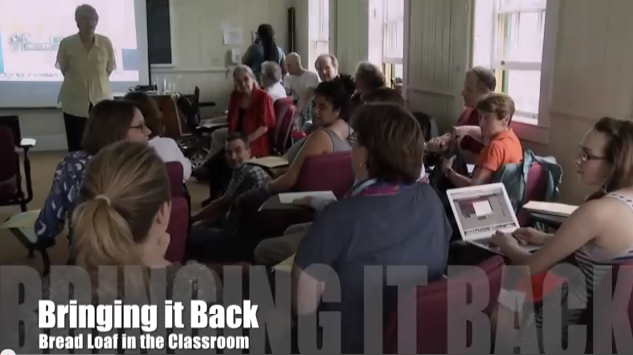Bringing it Back: Educating for Social Change
0May 14, 2014 by Dixie Goswami

Chris McCurry, Nell Whitman, and the other contributors to this issue claim that conversations initiated while studying at Bread Loaf and continued online are at the heart of BLTN. Diverse in its members’ opinions, cultures and experiences, BLTN exists within the traditions of the Bread Loaf School of English, an institution that provides education in British, American, and world literature, and the allied fields of pedagogy, literacy, creative writing, and theater arts. The “it” that’s written about here: teachers’ professional lives enriched and broadened by their Bread Loaf experience as they teach, learn, write, and educate for change. The crucial contributions of Bread Loaf faculty to BLTN are highlighted in these accounts that mention many professors, including Isobel Armstrong, Damian Baca, Django Paris, Andrea Lunsford, Cheryl Glenn, Michael Armstrong, Ruth Forman, and Caroline Bicks.
“Bringing It Back” clearly works two ways. BLTN teachers bring their ideas and experiences from their classrooms back to Bread Loaf and the network as they participate in courses, events, virtual exchanges, conversations, and activities. They also shape the network and their classrooms in profound ways as they read, think, and plan together over extended periods of time. They negotiate meanings and actions, defining what membership in this networked community within BLSE is and could be. As you’ll see from their reflections, these teachers use a range of digital tools to the advantage of their students, from Nell Whitman’s student-produced job profile videos to Laura Benton’s One to One iPad program and her students’ use of iMovie, Prezi. and Google Drive in Julius Caesar projects. Laura echoes the notion expressed by other contributors that the “it” is not technology:
More than anything else, I have simply enjoyed bringing Bread Loaf-inspired techniques back to my students. At BLTN meetings last summer, Professor Lunsford talked about the impact of digital media. The manifestos made me realize that our kids really do live in the “remix culture” she references. This is new, wild, and a bit scary, but also a fantastic way for students to think critically about their world and create collaborative and authentic work that speaks to their individual voices.
The “Bringing It Back” narratives help us gain a sense of what being part of an extended network working toward social change through education means; they suggest what BLTN can do. As networks for education and action proliferate at every level, having and sharing these understandings becomes an important goal, extending BLTN’s usefulness as a resource far beyond the Bread Loaf community.
Pass it Forward
“Bringing It Back” reflections form a powerful narrative about teachers as agents of change and sources of insight and knowledge about teaching and learning. Please share this issue of the BLTN Journal with colleagues, administrators, and policymakers who are working toward equity and excellence in education. Add your own “Bringing it Back” stories and comments.
– by Dixie Goswami, Director Bread Loaf Teacher NetworkLink directly to one of the following accounts of “Bringing it Back:”
- Paul Barnwell: Kentucky Collaborations
- Laura Benton: A Portrait of a Teacher as a BLTN Fellow
- Lorena German: Bringing it Back
- Teri Heisey: Bringing it Back
- Chantal Kenol Desmores: Bringing it Back to Haiti
- Chris McCurry: Forming and Reforming via Bread Loaf
- Holly Spinelli: Bringing it Back
- Nell Whitman: Bringing it Back
Category BLTN Teachers, Bringing it Back, Featured, Impacts, Issue, Spring 2014 | Tags:

Leave a Reply